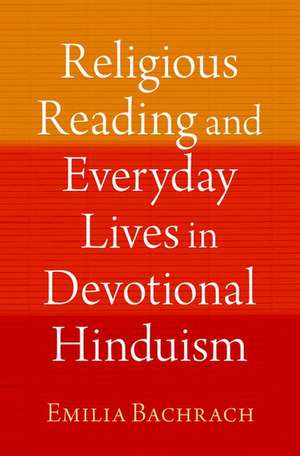Religious Reading and Everyday Lives in Devotional Hinduism: AAR RELIGION IN TRANSLATION
Autor Emilia Bachrachen Limba Engleză Hardback – 8 feb 2023
Preț: 437.75 lei
Preț vechi: 485.49 lei
-10% Nou
Puncte Express: 657
Preț estimativ în valută:
83.79€ • 91.05$ • 70.43£
83.79€ • 91.05$ • 70.43£
Carte disponibilă
Livrare economică 20-26 martie
Preluare comenzi: 021 569.72.76
Specificații
ISBN-13: 9780197648599
ISBN-10: 0197648592
Pagini: 264
Dimensiuni: 242 x 162 x 24 mm
Greutate: 0.52 kg
Editura: Oxford University Press
Colecția OUP USA
Seria AAR RELIGION IN TRANSLATION
Locul publicării:New York, United States
ISBN-10: 0197648592
Pagini: 264
Dimensiuni: 242 x 162 x 24 mm
Greutate: 0.52 kg
Editura: Oxford University Press
Colecția OUP USA
Seria AAR RELIGION IN TRANSLATION
Locul publicării:New York, United States
Recenzii
Bachrach sensitively guides the reader into the contemporary life of the Pushtimarg's vārtā traditions with the vibrance of the satsaṅg gatherings she portrays. While never losing her analytical distance, she insinuates herself into the performances of these texts so the reader cannot fail to gauge the emotional tenor of what these stories mean to their devotees. The boundary between text and auditor in the satsaṅg dissolves in the act of reading and commenting, an embodied improvisation that transforms the vārtās into a living canon.
A charmingly disarming question—Can one offer pizza to God/Krishna?—opens this rich 'ethnography of reading' that focuses on contemporary middle-class women devotees of the Pushtimarg sect. Though this tradition is perhaps better known to outsiders for its opulent ritual art, Bachrach details how intense interaction with a large corpus of 17th century hagiography—transmitted and debated through oral performance, print media, and (now) websites and social media platforms—continues to inform and inflect its often cosmopolitan adherents' daily lives, family relationships, and experiences of both devotion and agency.
Picture a group of Gujarati women on a Thursday afternoon reading a 17th-century hagiography of a Hindu Pushtimarg follower that leads to their discussion of whether or not they can offer pizza to Krishna, and you will grasp what Emilia Bachrach notably characterizes as a 'performative canon' of engaged responses that distinctively shape a relevant continuity with tradition. Devotional reading is a primary religious mode, in which devotees' lively discussions make the past palpable, the present morally actionable, and the future expansive for the Pushtimarg community. Bachrach's illuminating analysis is essential to understanding lived religion in India and comparatively.
Religious Reading and Everyday Lives in Devotional Hinduism will appeal to students, scholars, and readers in ethnography, South Asian religion, psychology of religion, and Hindu studies.
Religious Reading and Everyday Lives in Devotional Hinduism should find extensive readership among scholars interested in Hindu devotional and narrative literature, the development of modern Hinduism, and practices of religious reading. Bachrach's clear and engaging prose makes the book accessible to both specialists and non-specialists alike, and I look forward to incorporating the book into my own teaching repertoire.
A charmingly disarming question—Can one offer pizza to God/Krishna?—opens this rich 'ethnography of reading' that focuses on contemporary middle-class women devotees of the Pushtimarg sect. Though this tradition is perhaps better known to outsiders for its opulent ritual art, Bachrach details how intense interaction with a large corpus of 17th century hagiography—transmitted and debated through oral performance, print media, and (now) websites and social media platforms—continues to inform and inflect its often cosmopolitan adherents' daily lives, family relationships, and experiences of both devotion and agency.
Picture a group of Gujarati women on a Thursday afternoon reading a 17th-century hagiography of a Hindu Pushtimarg follower that leads to their discussion of whether or not they can offer pizza to Krishna, and you will grasp what Emilia Bachrach notably characterizes as a 'performative canon' of engaged responses that distinctively shape a relevant continuity with tradition. Devotional reading is a primary religious mode, in which devotees' lively discussions make the past palpable, the present morally actionable, and the future expansive for the Pushtimarg community. Bachrach's illuminating analysis is essential to understanding lived religion in India and comparatively.
Religious Reading and Everyday Lives in Devotional Hinduism will appeal to students, scholars, and readers in ethnography, South Asian religion, psychology of religion, and Hindu studies.
Religious Reading and Everyday Lives in Devotional Hinduism should find extensive readership among scholars interested in Hindu devotional and narrative literature, the development of modern Hinduism, and practices of religious reading. Bachrach's clear and engaging prose makes the book accessible to both specialists and non-specialists alike, and I look forward to incorporating the book into my own teaching repertoire.
Notă biografică
Emilia Bachrach is Assistant Professor of Religion and Gender, Sexuality, and Feminist Studies at Oberlin College. Her research focuses on how people's interpretations of religious texts inform and are informed by intimate negotiations of the family and the self, and by changing class, regional, and gender identities in contemporary western India. She also works with oral and written texts in early modern and modern languages, including Braj Bhasha, Gujarati, and Hindi.

